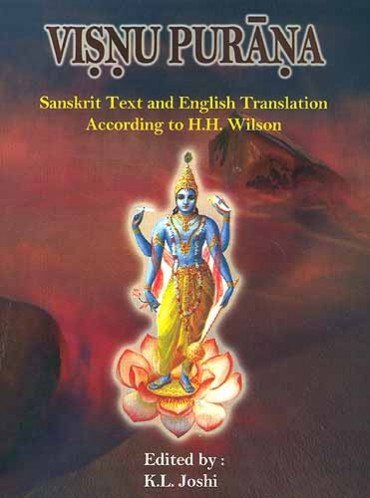The Vishnu Purana
by Horace Hayman Wilson | 1840 | 287,946 words | ISBN-10: 8171102127
The English translation of the Vishnu Purana. This is a primary sacred text of the Vaishnava branch of Hinduism. It is one of the eighteen greater Puranas, a branch of sacred Vedic literature which was first committed to writing during the first millennium of the common era. Like most of the other Puranas, this is a complete narrative from the cr...
Chapter XI - The sun distinct from, and supreme over, the attendants on his car
Maitreya said:—
You have related to me, holy preceptor, the seven classes of beings who are ever present in the solar orb, and are the causes of heat and cold: you have also described to me their individual functions, sustained by the energy of Viṣṇu: but you have not told me the duty of the sun himself; for if, as you say, the seven beings in his sphere are the causes of heat, cold, and rain, how can it be also true, as you have before mentioned, that rain proceeds from the sun? or how can it be asserted that the sun rises, reaches the meridian, or sets, if these situations be the act of the collective seven.
Parāśara said:—
I will explain to you, Maitreya, the subject of your inquiry. The sun, though identified with the seven beings in his orb, is distinct from them as their chief. The entire and mighty energy of Viṣṇu, which is called the three Vedas, or Rich, Yajush, and Sāman, is that which enlightens the world, and destroys its iniquity. It is that also which, during the continuance of things, is present as Viṣṇu, actively engaged in the preservation of the universe, and abiding as the three Vedas within the sun. The solar luminary, that appears in every month, is nothing else than that very supreme energy of Viṣṇu which is composed of the three Vedas, influencing the motions of the planet; for the Ricas (the hymns of the Rig-veda) shine in the morning, the prayers of the Yajush at noon, and the Vrihadrathantara and other portions of the Sāman in the afternoon. This triple impersonation of Viṣṇu, distinguished by the titles of the three Vedas, is the energy of Viṣṇu, which influences the positions of the sun[1].
But this triple energy of Viṣṇu is not limited to the sun alone, for Brahmā, Puruṣa (Viṣṇu), and Rudra are also made up of the same triform essence. In creation it is Brahmā, consisting of the Rig-veda in preservation it is Viṣṇu, composed of the Yajur-veda; and in destruction Rudra, formed of the Sāma-veda, the utterance of which is consequently inauspicious[2].
Thus the energy of Viṣṇu, made up of the three Vedas, and derived from the property of goodness, presides in the sun, along with the seven beings belonging to it; and through the presence of this power the planet shines with intense radiance, dispersing with his beams the darkness that spreads over the whole world: and hence the Munis praise him, the quiristers and nymphs of heaven sing and dance before him, and fierce spirits and holy sages attend upon his path. Viṣṇu, in the form of his active energy, never either rises or sets, and is at once the. sevenfold sun and distinct from it. In the same manner as a man approaching a mirror, placed upon a stand, beholds in it his own image, so the energy (or reflection) of Viṣṇu is never disjoined (from the sun's car, which is the stand of the mirror), but remains month by month in the sun (as in the mirror), which is there stationed.
The sovereign sun, oh Brahman, the cause of day and night, perpetually revolves, affording delight to the gods, to the progenitors, and to mankind. Cerished by the Suṣumna ray of the sun[3], the moon is fed to the full in the fortnight of its growth; and in the fortnight of its wane the ambrosia of its substance is perpetually drunk by the immortals, until the last day of the half month, when the two remaining digits are drunk by the progenitors: hence these two orders of beings are nourished by the sun. The moisture of the earth, which the sun attracts by his rays, he again parts with for the fertilization of the grain, and the nutriment of all terrestrial creatures; and consequently the sun is the source of subsistence to every class of living things, to gods, progenitors, mankind, and the rest. The sun, Maitreya, satisfies the wants of the gods for a fortnight (at a time); those of the progenitors once a month; and those of men and other animals daily.
Footnotes and references:
[1]:
This mysticism originates in part apparently from a misapprehension of metaphorical texts of the Vedas, such as ‘that triple knowledge (the Vedas) shines;’ and ‘the hymns of the Rich shine;’ and in part from the symbolization of the light of religious truth by the light of the p. 236 sun, as in the Gāyatri, p. 222. n. 13. To these are to be added the sectarial notions of the Vaiṣṇavas.
[2]:
The formulæ of the Sāma-veda are not to be used along with those of the Rich and Yajush, at sacrifices in general.
[3]:
The Vāyu, Liṅga, and Matsya P. specify several of the rays of the sun from amongst the many thousands which they say proceed from him. Of these, seven are principal, termed Suṣumna, Harikeśa, Viśvakarman, Viśvakārya, Sampadvasu, Arvavasu, and Svarāj, supplying heat severally to the moon, the stars, and to Mercury, Venus, Mars, Jupiter, and Saturn.
